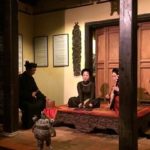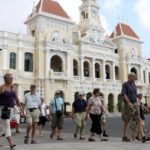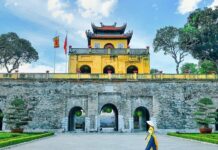Pen Tower and Ngoc Son Temple take on a shimmering and enchanting appearance under the multicolored light, which is completely different from their usual ancient look that is seen every day.
The Hanoi Management Board for Heritage Sites and Scenic Landscapes launched the Mysterious Night at Ngoc Son Temple experience program on January 31. This program aims to provide a more immersive experience for tourists visiting the capital city.
The program focuses on showcasing the beauty of the ancient architecture of Ngoc Son Temple and the legendary stories associated with the monument.
| Pen Tower illuminated by colorful lights. Photo: The Hanoi Times |
Ngoc Son Temple, also known as the Temple of Jade Mountain, was built in the 19th century and is considered a must-visit attraction in Hanoi.
The temple is dedicated to Van Xuong De Quan (Wenchang Dijun), a Taoist deity associated with dignity and happiness, and General Tran Hung Dao (1228-1300), a historical figure who played a significant role in leading the national resistance against the Mongol invaders in the 13th century.
In 1865, Nguyen Sieu, a Confucian scholar, was entrusted with the renovation of the temple. He inscribed the words “Happiness” and “Prosperity” in Sino-Vietnamese script at the entrance, symbolizing his wish for the well-being of the people.
On Ngoc Boi Mountain, there stands a pen-shaped tower made of stone, bearing the inscription “Ta Thanh Thien” (to write on the blue sky). This tower is commonly known as Pen Tower.
Ngoc Son Temple is located on Ngoc (Jade) Island in Sword Lake. Visitors can reach the temple by crossing the red wooden bridge called The Huc, which connects to Dinh Tien Hoang Street.
| The Dance of the Sun Goddess on the Huc Bridge. Photo: The Hanoi Times |
Ngoc Son Temple and Sword Lake hold a special place in the hearts of Vietnamese people due to their association with the legend of King Le Loi, a national hero who defeated Chinese invaders with a sacred sword bestowed upon him by the gods. He returned the sword to a giant turtle, which then disappeared under the water.
The lake serves as a symbol of the Vietnamese people’s aspiration for peace and their unwavering determination to protect the country’s sovereignty and independence.
The legend is brought to life through the night tourism program, where director Le Quy Duong combines sound, light, and modern projection technology to present traditional Vietnamese cultural values in an innovative way to visitors.
| The program features a combination of modern lighting system, traditional dance, and music. Photo: The Hanoi Times |
According to director Le Quy Duong, Ngoc Son Temple is not only a unique landscape but also a significant historical, political, cultural, artistic, and spiritual relic. It serves as an endless source of inspiration and energy for Hanoi and the whole nation.
“I feel honored and privileged to have the opportunity to write the script and produce this meaningful program. Together with Meritorious artist Dang To Nhu, we have created an exciting journey that gradually uncovers the hidden and mysterious beauty inherent in the ancient features of Ngoc Son Temple,” said Duong.
The program is divided into five main themes, each corresponding to a specific architectural area within the Ngoc Son Temple complex. These include the Ceremony of Giving Holy Words in the Pen Tower Area, the Ritual of Welcoming the Spirit of Heaven and Earth in the Huc Bridge Area, the Reviving the Legend of King Le Loi’s Return of the Sword in the Lake Area in front of Tran Ba Pavilion, the Prayer Ceremony in the Main Temple Area, and the Visitors’ Gallery of Specimens of the World’s Sea Turtle.
By leveraging the ancient architecture of this special national relic and its associated rituals and folklore, the program utilizes sound, light, and modern projection technology to showcase Vietnam’s traditional cultural values.
| Visitors will gain a deeper understanding of the legend of the Returning Sword. Photo: The Hanoi Times |
Through participating in this experience program, visitors can immerse themselves in traditional Vietnamese folk cultural rituals right at the location where their ancestors once performed these ceremonies.
Nguyen Doan Van, Director of Hanoi’s Management Board for Heritage Sites and Scenic Landscapes, believes that this program will provide a captivating experience, particularly for the younger generation and foreign tourists.
“I hope that Ngoc Son Temple will not only be a fascinating tourist attraction but also a centerpiece of night tourism and cultural industry that will capture the interest of both domestic and international visitors,” Van said.
The program will be available every Monday to Thursday evening. Each tour, lasting 60 minutes, is part of an experimental program and can accommodate between 60 and 70 visitors.
Vietnam Military History Museum receives Fatherland Protection Order
NDO – The Vietnam Military History Museum held a ceremony in Hanoi on July 15 to celebrate its 60th anniversary (1956-2016) and receive the Fatherland Protection Order, first class.
Ancient house in Ma May
NDO – Ma May, a rare quarter that still retains several old houses, has created one of the characteristics of Hanoi. Hanoi’s streets are becoming increasingly crowded and traditional features can sometimes be hidden behind modern life. But if one takes the time to relax and look around, the ancient features begin to reveal themselves.












